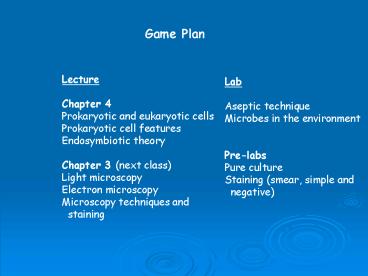Game Plan PowerPoint PPT Presentation
1 / 38
Title: Game Plan
1
Game Plan
Lecture Chapter 4 Prokaryotic and eukaryotic
cells Prokaryotic cell features Endosymbiotic
theory Chapter 3 (next class) Light
microscopy Electron microscopy Microscopy
techniques and staining
Lab Aseptic technique Microbes in the
environment Pre-labs Pure culture Staining
(smear, simple and negative)
2
CHAPTER 4 Prokaryotic vs. Eukaryotic cells
3
Bacterial cell shapes
4
Odd bacterial cell shapes
Figure 4.5 - Overview
5
Bacterial cell arrangements
Figure 4.1 - Overview
6
Prokaryotic cell overview
Figure 4.1 - Overview
7
Prokaryotic cell features
- Glycocalyx
- - Capsule
- - Slime layer
8
Prokaryotic cell features
- Glycocalyx
- Flagella
- - Arrangements
- - Chemotaxis
- - Motility
- - H antigens
Figure 4.7 - Overview
9
Prokaryotic cell features
- Glycocalyx
- Flagella
- Axial filaments
- (endoflagella)
Spirochete Leptospira interrogans
Figure 4.7 - Overview
10
Prokaryotic cell features
- Glycocalyx
- Flagella
- Axial filaments
- (endoflagella)
- Attachment pili
- (fimbriae)
11
Prokaryotic cell features
- Glycocalyx
- Flagella
- Axial filaments
- (endoflagella)
- Attachment pili
- (fimbriae)
- Conjugation pili
- (sex pili)
12
Prokaryotic cell features
- Glycocalyx
- Flagella
- Axial filaments
- (endoflagella)
- Attachment pili
- (fimbriae)
- Conjugation pili
- (sex pili)
- 6. Cell wall
Figure 4.13 - Overview
13
Gram positive versus Gram negative cells
14
Prokaryotic cell features
7. Plasma membrane
Figure 4.14 - Overview
15
Plasma membrane osmosis and tonicity
Figure 4.18 - Overview
16
Prokaryotic cell features
8. Ribosomes
Prokaryotic Eukaryotic 3 RNAs (23s, 16s, 5s) 4
RNAs (28s, 15s, 5.8s, 5s) 53 proteins 70
proteins 30S/ 50S subunits 40S/ 60S
subunits 70S ribosome 80S ribosome
Figure 4.19
17
Prokaryotic cell features
9. Endospores
18
Pit stop Which prokaryotic cell feature do you
think is most influential in contributing to
disease in humans and why?
19
Endosymbiotic theory
20
Endosymbiotic evidence
21
Independent study
1. What evidence suggests that mitochondria and
chloroplasts might have originally been free
living prokaryotic cells? Review chemical
bonds, properties of water, and organic
compounds for next lecture. Please see Chapter 2
PowerPoint on WebCT for a review of this
material. Extra credit assignment next class.
22
CHAPTER 3 Microscopy
23
Compound light microscope
Figure 3.1a
24
Properties of light
25
Refraction and immersion oil
Figure 3.3
26
Brightfield and darkfield microscopy
Figure 3.4 - Overview
27
Phase contrast and Nomarski optics (DIC)
Figure 3.5
Figure 3.4 - Overview
28
Fluorescence and confocal microscopy
Figure 3.6
Figure 3.7
29
Resolving power
30
Transmission Electron Microscopy (TEM)
Figure 3.9a
31
Scanning Electron Microscopy (SEM)
Figure 3.9b
32
SEM images
Fungus Aspergillus
Didinium eating Paramecium (protozoa)
Protozoan Radiolarian
33
SEM images
Bacillus anthracis sporulation (bacterium)
Alga Ceratium
Penicillium notatum conidiophore (fungus)
SEMs courtesy of Dennis Kunkel Inc.
34
Microscopy Basics
- Living preparations
- Wet mount
- Hanging drop
35
Microscopy Basics
- Living preparations
- Wet mount
- Hanging drop
- Stained preparations
- Basic vs. acidic dyes
- Simple stains
- Differential and special
- stains
36
Differential stains- The Gram Stain
Figure 3.11a
37
Differential and special stains
Figure 3.12 and 3.13
38
Independent study
- 1. Why do we see Gram positive and Gram negative
cells? What - is the key structural difference (on a cellular
level) that could account - for this difference?
- Review aerobic respiration the starting
compounds and end products - of glycolysis, the Krebs cycle, and the electron
transport chain - (see figure 5.17).
- Review the light dependent and light independent
reactions of - photosynthesis (see Figure 5.24 and 5.25).

